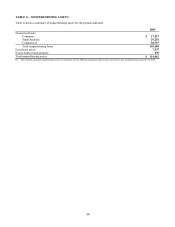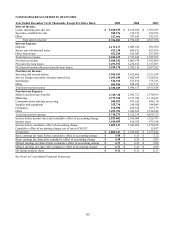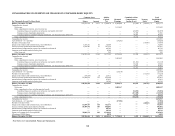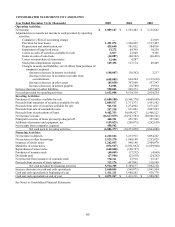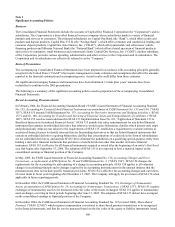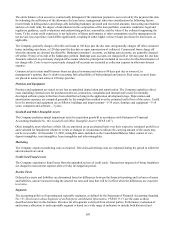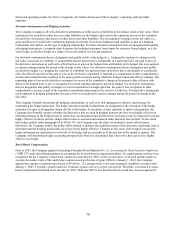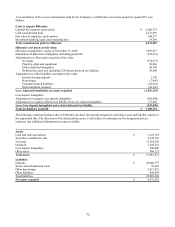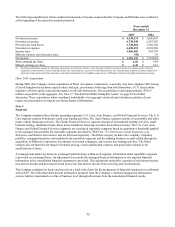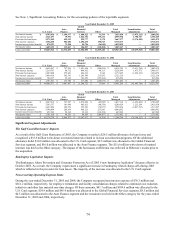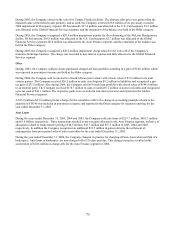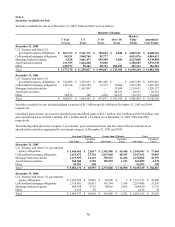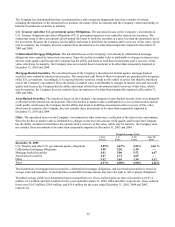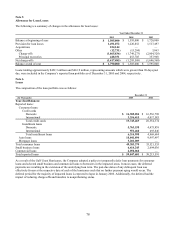Capital One 2005 Annual Report Download - page 78
Download and view the complete annual report
Please find page 78 of the 2005 Capital One annual report below. You can navigate through the pages in the report by either clicking on the pages listed below, or by using the keyword search tool below to find specific information within the annual report.The entire balance of an account is contractually delinquent if the minimum payment is not received by the payment due date.
In evaluating the sufficiency of the allowance for loan losses, management takes into consideration the following factors:
recent trends in delinquencies and charge-offs including bankrupt, deceased and recovered amounts; forecasting uncertainties
and size of credit risks; the degree of risk inherent in the composition of the loan portfolio; economic conditions; legal and
regulatory guidance; credit evaluations and underwriting policies; seasonality; and the value of the collateral supporting the
loans. To the extent credit experience is not indicative of future performance or other assumptions used by management do
not prevail, loss experience could differ significantly, resulting in either higher or lower future provision for loan losses, as
pplicable. a
The Company generally charges off credit card loans at 180 days past the due date, and generally charges off other consumer
loans, including auto loans, at 120 days past the due date or upon repossession of collateral. Commercial loans charge off
when the amounts are deemed uncollectible. Bankrupt consumers’ accounts, excluding auto accounts, are generally charged-
off within 30 days of receipt of the bankruptcy petition. Bankrupt auto accounts are charged-off at 120 days past the due date.
Amounts collected on previously charged-off accounts related to principal are included in recoveries for the determination of
net charge-offs. Costs to recover previously charged-off accounts are recorded as collection expense in other non-interest
expense.
Commercial and certain small business loans are placed in nonaccrual status at 90 days past due or sooner if, in
management’ s opinion, there is doubt concerning full collectibility of both principal and interest. Real estate secured loans
re placed in nonaccrual status at 180 days past due. a
Premises and Equipment
Premises and equipment are stated at cost less accumulated depreciation and amortization. The Company capitalizes direct
costs (including external costs for purchased software, contractors, consultants and internal staff costs) for internally
developed software projects that have been identified as being in the application development stage. Depreciation and
amortization expenses are computed generally by the straight-line method over the estimated useful lives of the assets. Useful
lives for premises and equipment are as follows: buildings and improvements—5-39 years; furniture and equipment—3-10
ears; computers and software—3 years. y
G
oodwill and Other Intangible Assets
The Company performs annual impairment tests for acquisition goodwill in accordance with Statement of Financial
Accounting Standards No. 142, Goodwill and Other Intangible Assets (“SFAS 142”).
Other intangible assets that have a finite life are amortized on an accelerated basis over their respective estimated useful lives
and evaluated for impairment whenever events or changes in circumstances indicate the carrying amount of the assets may
not be recoverable. At December 31, 2005, intangible assets included on the Consolidated Balance Sheet consist of core
deposit intangibles, trust intangibles, lease intangibles and other intangibles.
Marketing
The Company expenses marketing costs as incurred. Television advertising costs are expensed during the period in which the
dvertisements are aired. a
C
redit Card Fraud Losses
The Company experiences fraud losses from the unauthorized use of credit cards. Transactions suspected of being fraudulent
are charged to non-interest expense after a 60 day investigation period.
In
come Taxes
Deferred tax assets and liabilities are determined based on differences between the financial reporting and tax bases of assets
and liabilities, and are measured using the enacted tax rates and laws that will be in effect when the differences are expected
t reverse. o
S
egments
The accounting policies of operating and reportable segments, as defined by the Statement of Financial Accounting Standard
No. 131, Disclosures about Segments of an Enterprise and Related Information, (“SFAS 131”) are the same as those
described elsewhere in this footnote. Revenue for all segments is derived from external parties. Performance evaluation of
and resource allocation to each reportable segment is based on a wide range of indicators to include both historical and
69


